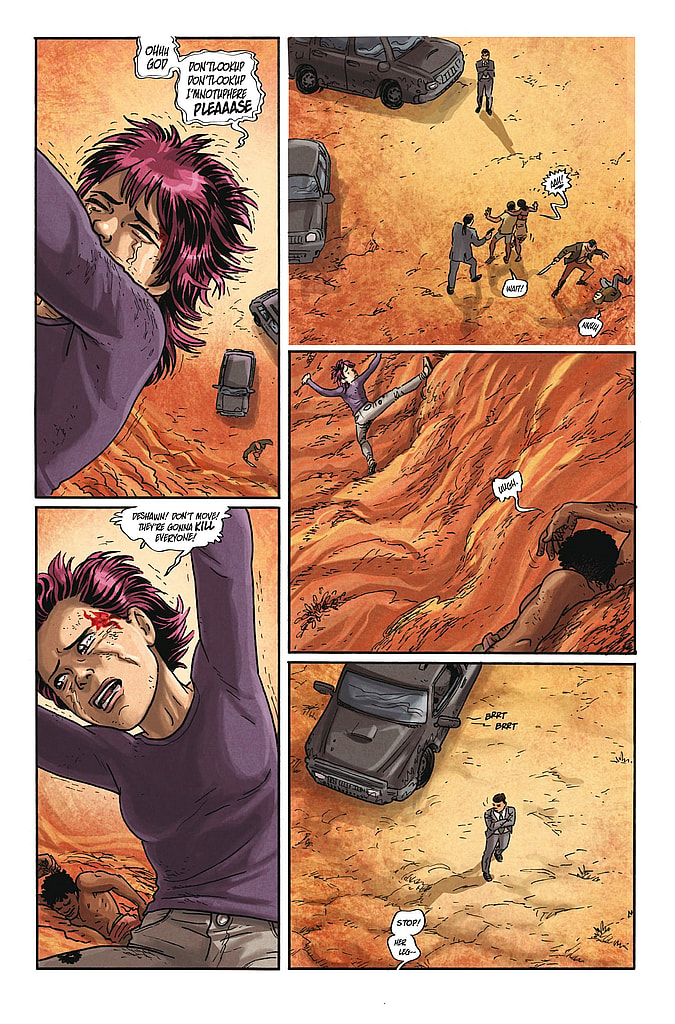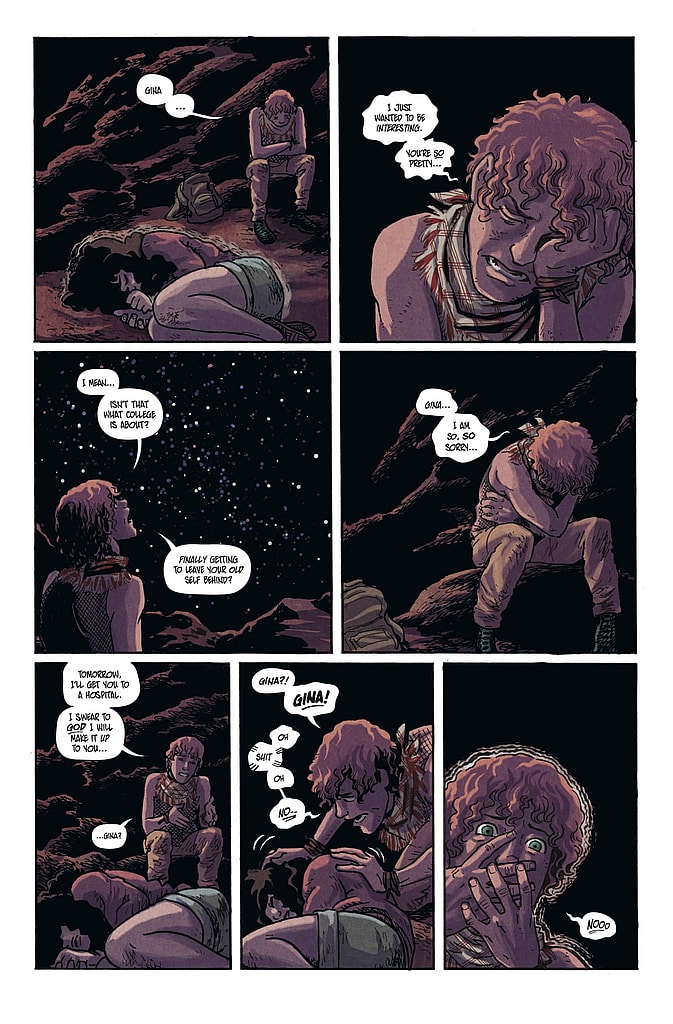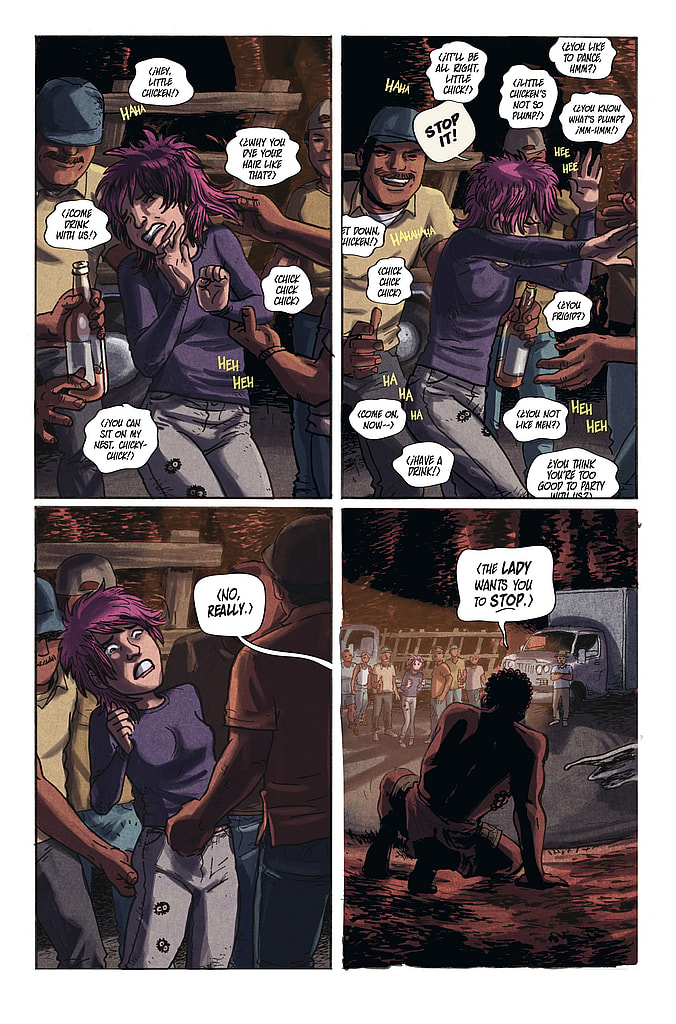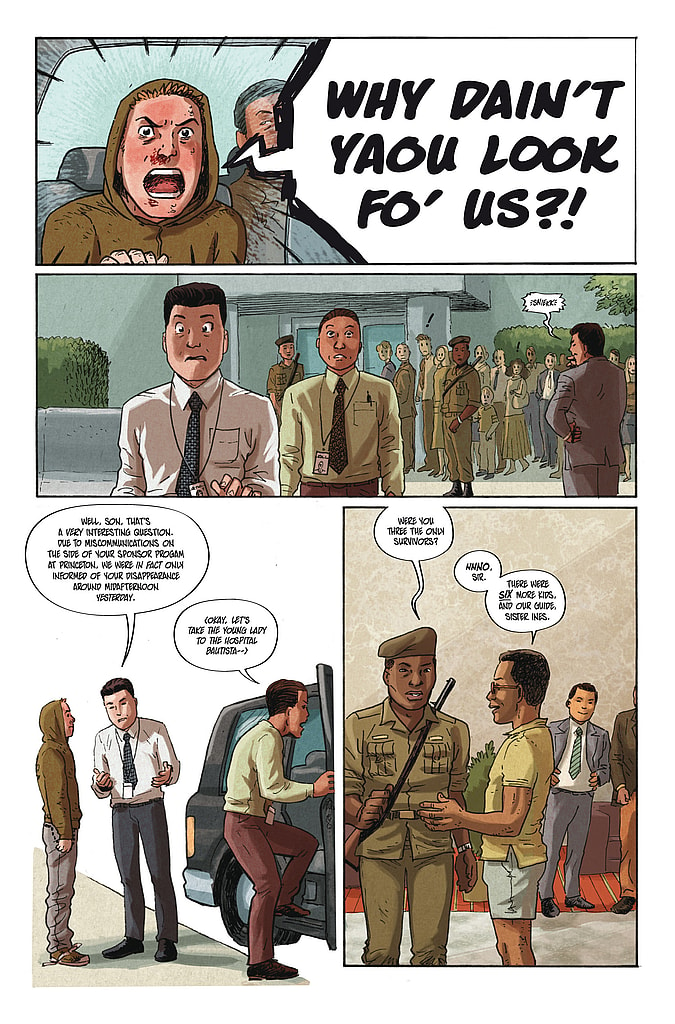Interview: Exploring the Horror of Service with “No Mercy” Creators Alex de Campi, Carla Speed Mcneil, and Jenn Manley Lee

No Mercy, published by Image, is a very interesting and thrilling comic book by Alex De Campi, Carla Speed McNeil, and Jenn Manley Lee.
With issue five coming out December 9, we’ve asked the creative team a few questions about the book, how it came to be, and what’s ahead for the future. You can also read our review of No Mercy, Vol. 1 right here.
BiC: For any new readers out there, can you give us a few words on what No Mercy is?
Alex: It’s a book about texting, emoji and sudden death in Central America. For the film nerds, I like to say it’s a John Hughes script directed by Sam Peckinpah. Basically, a bunch of teens go do a university-sponsored volontourism trip right before their freshman year. On the way to their remote mountain village where they are to build schools, a Very Bad Thing happens. They never make it to the village. Most won’t ever make it home. We’re about to start the new arc, and there’s a lovely cheap Image $9.99 trade of the first arc.
BiC: I was surprised by how cruel the first arc was. What makes you attracted to the sort of stories like this one or Grindhouse that are more horror and thrill oriented?
Alex: I’m dead inside and it takes a lot to make me feel. No, seriously. I guess a sort of casual brutality is a hallmark of my work. I’ve seen actual very bad things happen, and they always happen so fast, and without any expectation for how severe the situation will suddenly be. All I try to do is present that realistically in my books.
BiC: The cast of characters is extremely diverse but also very realistic, they talk and behave like actual teenagers I know. Do you find it difficult to capture this current teenage generation?
Alex: Not really. It’s possibly easier than it ever was, due to social media. Writers are the most terrible parasites; we consume others’ lives as content and then regurgitate it into our characters. I spend a lot of time listening.
BiC: Who are your favorite characters to write? Why?
Alex: “I guess they are all my sons.” It’s true; I love ’em all, from Tiffani’s doofyness to Kira’s sharpness. I know a lot more about them than you do, so part of my love and thrill is I know how they will change.
BiC: Carla, you’re most famous for your creator owned book Finder. How different of an experience is it to draw on a book somebody else writes compared to the ones you write yourself?
Speed: I’ve looked for collaborations with writers from the start. I drew a marvelous Hedy Lamarr story for NYT besteller Jim Ottaviani, I drew an experimental detective comic for all-around big dog Warren Ellis, I drew a QUEEN & COUNTRY book for Greg Rucka, and others, and I’ve loved them all. When a writer knows both exactly what he or she wants but also knows where there’s room for me to bring what I can do to a project, there’s plenty of room for me as an artist and writer to make good comics.
BiC: What made you attracted to the concept and the universe of No Mercy?
Speed: I’d drawn a chunk of Alex’s ASHES earlier (I got to draw my very first super secret evil lab!) and we’d worked well together. We met later that year at a con, and she blurted “You do good teenagers, you wanna do a thing?” and that was that.
BiC: Many artists would have went for a more gory direction on such a book yet you didnt fall into that trap. Was this a conscious choice? Can we expect things to become more graphic as the story moves along?
Speed: Maybe other artists are better at gore? I thought the part where poor Lily’s getting disembowelled by a piranhacoyote was pretty gory. I’ll work on it.
BiC: Have there been any specific challenges you’ve been faced with in terms of art on this book?
Speed: We all wanted to make sure that our setting, although fictional, rang true. That meant having normal, ordinary people doing normal, ordinary things, having lives, apart from all the crazy stuff. We didn’t want it to be a bizarre fantasyland where only horrible things happen. Didn’t want it to be only a lens through which we see these American tourists and their troubles. That’s a thing I’ve always striven to do, even if it’s just trying to make it look like there are a lot of stories you’re missing out on in the people you see and never see again.
BiC: Jenn, I was surprised to see the colors are all done digitally, it really feels like paint on paper. Is that effect difficult to emulate? How do you achieve it?
Jenn: It doesn’t feel difficult to me, but, well, only natural. I started as a painter and that’s how I approach coloring first and foremost. I previously worked in watercolor and gouache and that’s the look I favor, building tone and light in a similar manner. I really don’t consider the digital aspect of it.
That said, I’ve spent years creating and collecting digital brushes and textures as well as getting familiar with how to get the software to do what I want quickly and with little to no effort.
I think another aspect that lends an even greater feel of paint on paper in No Mercy is Carla’s request of an actual paper texture on the art. This was a challenge to do in a way I felt looked like color on paper instead of just a texture slapped across color. Ironically, it often means removing the texture in some parts as well as blending it in with different effects.
BiC: How do you work with Carla, are there a lot of instructions given between an artist and a colorist? How about you and Alex?
Jenn: Actually, I received no specific color direction at the get go, not even to the coloration of the main cast. Due to time restraints and conflicting schedules, I didn’t even get to see Alex’s script for issue 1!
However, I’ve known and worked with Carla enough to know what she likes and how to interpret her art into color. That along with a general discussion about what Alex wanted for atmosphere and what Carla was looking at for inspiration helped guide me through coloring that first issue with the only requests being one hair color change (from pink to purple) and the color of a few of the shirts switched out.
Since that first issue I’ve been able to read all of Alex’s scripts which allows me to pick up light and color cues, which combined with constant communication with her and Carla, directly about color or not, tends to fill in the rest for me.
But still no direct instructions. The thing is, what’s so gratifying with working with Alex and Carla is that they trust and respect my ability and judgement and value what I bring to the team. That and they are not afraid to tell me when they think I’ve missed the mark or simply want something else.
BiC: I was particularly impressed by the bus explosion, it looked fantastic. Was that difficult to do? Have there been any particularly challenging scenes in terms of coloring?
Jenn: Thanks and no, blowing up that damn bus was fun and pretty simple. Any scene with strong action or emotion come very readily and therefore speedily to me. It’s the vague scenes and settings that tend to slow me down and frustrate me.
But really, the most troublesome thing to color was that damn bus and it’s elaborate paint job. I was unabashedly pleased when it went off the cliff and positively gleeful when it was blown up!
BiC: An all female creative team is not something we see everyday in comics. How did this team come to be?
Alex: By happenstance. I was at Baltimore Comic-Con chatting to Carla a few years ago and mentioned No Mercy; she wanted to draw it; and Jenn does a particularly fabulous job colouring Carla’s line art. I’ve worked with a bunch of all female teams before, from Kat & Mouse at Tokyopop onwards. It’s never something we plan out, although obviously as a woman I’m perhaps more aware of female artists.
Jenn: As Alex said. And I have a feeling this’ll be a less remarkable composition of a team very soon.
Speed: Alex approached me; Jenn had done color on FINDER. It wasn’t a thing we consciously set out to do.
BiC: Do you feel having a diverse cast of characters resulted in a more diverse readership so far? Is diversity in comic books (in terms of cast and creators) something you feel is important?
Alex: We didn’t plan a diverse cast to get more readers (although there are a lot of comics companies driving past a lot of open wallets, it has to be said). As I mentioned earlier, I’m big on accurately reflecting reality in my books and the reality is that trip would not be a bunch of straight white kids. Of course, having a diverse cast does give me more breadth for more kinds of drama. And the response has been really positive; I do think, for example, putting Kira on the cover of #4 caused a lot of people to pick the book up for the first time (it certainly causes people to stop at the table at conventions and pick the issue up).
Representation is terribly important. Everyone deserves to be the hero of a story, to swing the sword and save the day. What are we telling girls, and/or minorities, if they never get to be the hero, or aren’t even in the book? We’re telling little children that they don’t matter; that they’re less important than another kind of kid. That has tremendous, awful, far-reaching effects.
Jenn: As I grew up in central New Jersey, not far from Princeton where all these kids are entering as Freshmen, this seems a perfectly normal mix of ethnic backgrounds. I think that’d be true for most readers, period. Which can only make the situation more believable and relatable no matter what your personal ancestory or culture.
Speed: Most definitely. Of course, there might be other approaches that might be fun; I’d love to do a high fantasy in a world in which all the characters, from elves and wizards and lost heirs to the throne and heavenly messengers and ordinary grounded people who are more concerned with dinner and the harvest than magic were all of African descent. That could be a remarkably diverse book.
BiC: What can we expect from the next story arc? Do you know how long the series will be in the end?
Alex: Murder. Mayhem. A particularly fine maiming. And to see the rock we threw in the water in the first arc — the kids, their Very Bad Thing — ripple outwards to start to encompass parents and school administrators. And the Blame Game begins. The book will probably be (sales permitting) a total of six arcs. I’ve mapped out the next two and have sketches of the rest.
BiC: Anything you want to add about No Mercy? Do you have other projects you are working on?
Alex: If you like No Mercy, consider picking up my Dark Horse books: Grindhouse, Archie vs Predator, Smoke/Ashes (Carla and my first work together!). I also have an epic fantasy thriller, Valentine, on ComiXology.
Speed: I look forward to whatever Alex asks for in the covers. There are some gorgeous covers out there these days, and Alex is good at dressing up what I send in… also I love working with a writer who says things like “take this hard-bitten ex-Cartelista nun and do a Disney princess dream version of her, down to the last sparkle and twirl, and don’t forget the bluebird.”
Also, I started my new FINDER story, subtitled CHASE THE LADY, in DARK HORSE PRESENTS last month. This one’s basically an Edith Wharton/Downton Abbey story in which a penniless aristocrat, having survived the worst coming-out party ever, now really has to find love and get married before her fifteen minutes of fame run out, all in a weird science fiction setting that’s all my own.
Jenn: Besides coloring just about everything Carla draws, I do a long running webcomic called Dicebox, which can be found at Dicebox.net. From there you can find my various footholds on the internet.
No Mercy #5 will be available for purchase on December 9, 2015.
You can also watch the trailer for the upcoming story arc below!
No Mercy: trailer from alex de campi on Vimeo.




